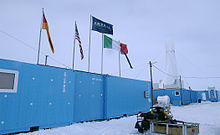|
ANDRILL
ANDRILL (ANtarctic DRILLing Project) is a scientific drilling project in Antarctica gathering information about past periods of global warming and cooling.[1] The project involves scientists from Germany, Italy, New Zealand, and the United States.[1][2] The project is based at McMurdo Station in Antarctica.[3] At two sites in 2006 and 2007, ANDRILL team members drilled through ice, seawater, sediment and rock to a depth over more than 1,200 m (3,900 ft) and recovered a virtually continuous core record from the present to nearly 20 million years ago.[2] Work
In studying the cores, ANDRILL scientists from various disciplines are gathering detailed information about past periods of global warming and cooling.[2] A major goal of the project is to significantly improve the understanding of Antarctica's impact on the world's oceans currents and the atmosphere by reconstructing the behavior of Antarctic sea-ice, ice-shelves, glaciers and sea currents over tens of millions of years.[4] When sea ice forms, it pushes the salt out, creating a mass of cold, salty, dense water that sinks to the bottom of the ocean, creating deep ocean currents that affect ocean circulation and the distribution of heat worldwide.[3][5] Initial results imply rapid changes and dramatically different climates at various times on the southernmost continent.[2][6] The $30 million project has achieved its operational goal of retrieving a continuous core record of the last 17 million years, filling crucial gaps left by previous drilling projects.[7] Making use of knowledge gained through prior Antarctic drilling projects, ANDRILL employed novel techniques to reach record depths at its two drilling sites.[citation needed] Among the innovations deployed were a hot-water drilling system that allowed for easier ice-boring and a flexible drill pipe that could accommodate tidal oscillations and strong currents.[citation needed] On December 26, 2006, ANDRILL broke the previous record of 999.1 m (3,277.9 ft) set in 2000 by the Ocean Drilling Program's drill ship, the Joides Resolution.[8] The record-breaking core measured 1,284.87 m (4,215 ft).[8] In 2007, drilling at the Southern McMurdo Sound, ANDRILL scientists recovered another 1,138 m (3,734 ft) of core.[citation needed] One goal in 2006 was to look at a period of around 3 to 5 million years ago in the Pliocene, which scientists know to be warmer.[citation needed] The team's sedimentologists identified more than 60 cycles in which ice sheets or glaciers advanced and retreated across McMurdo Sound.[3][9]  Geologist David Harwood, who was principal investigator and co-chief scientist of the 2007 season,[3] explained that understanding what happened in the warm period is especially important as Earth's climate continues to warm:
Virtual Field TripThe New Zealand online education programme, LEARNZ, conducted a virtual field trip to the Ross Sea drill site in November 2006.[4] In 2007, over 3,500 New Zealand school students joined LEARNZ teacher Darren on this trip.[citation needed] Telephone conferences were held between students and ANDRILL scientists from the drill site and the Crary Laboratory at McMurdo station.[10] Media coverageNBC's news anchor Ann Curry reported from the ANDRILL camp at the U.S. McMurdo Base for a week beginning October 2, 2007.[11] Ann Curry, reporting for a series called "Ends of the Earth," had hoped to tape at the South Pole, was held up at McMurdo due to severe weather conditions.[12] The weather broke and about 1 a.m. local time on Friday, Nov. 9, Curry and crew finally touched down at the South Pole.[12] It is not unusual for there to be flight delays to South Pole in the early part of the austral summer. [12] References
External linksWikimedia Commons has media related to ANDRILL. |
||||||||||||||||

